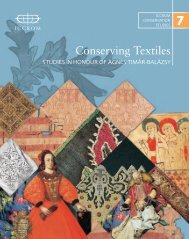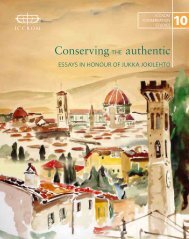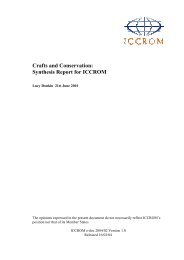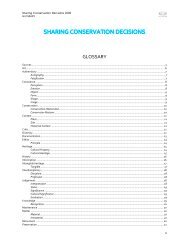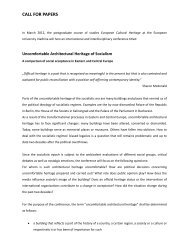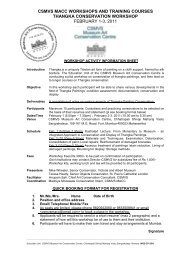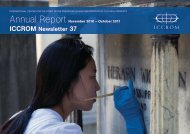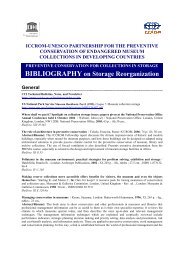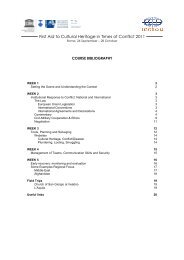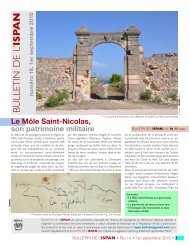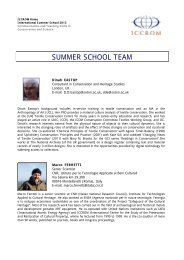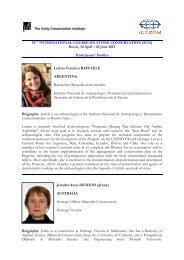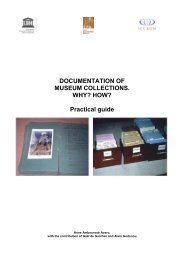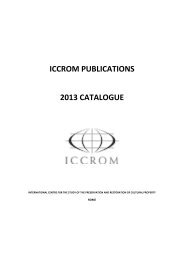part 1 - Iccrom
part 1 - Iccrom
part 1 - Iccrom
You also want an ePaper? Increase the reach of your titles
YUMPU automatically turns print PDFs into web optimized ePapers that Google loves.
MEASURING HERITAGE CONSERVATION PERFORMANCE<br />
6th International Seminar on Urban Conservation<br />
that promote knowledge management. (Consejo<br />
Nacional de la Cultura y de las Artes, 2009, p. 37)<br />
By strengthening the documentation of these<br />
‘community practices’ as mentioned above, one is<br />
also conducting conservation or safeguarding work<br />
as a means to preserve against negligence, destruction<br />
or misuse of the performances, demonstrations<br />
and cultural performances of villages. These all provide<br />
for the adoption of a series of measures aimed<br />
at identifying optimal factual knowledge, protecting<br />
(which is <strong>part</strong> of the role of documentation), promoting<br />
as an approach to other areas, revitalizing to<br />
avoid extinction or misuse and diffusion in terms of<br />
transmission of the various economic aspects. This<br />
means, therefore, its protection and conservation.<br />
The statement in Article 2 of the General Provisions,<br />
of the Convention for the Safeguarding of the Intangible<br />
Cultural Heritage reflects this:<br />
“‘Safeguarding’ means measures aimed at<br />
ensuring the viability of the intangible cultural<br />
heritage, including the identification, documentation,<br />
research, preservation, protection,<br />
promotion, enhancement, transmission, <strong>part</strong>icularly<br />
through formal and non-formal education,<br />
as well as the revitalization of the various<br />
aspects of such heritage.”(UNESCO, 2003).<br />
Life can be inferred from each and every one of<br />
these issues highlighted because they are concatenated<br />
to the extent they are adding to the identification<br />
and ownership of communities with respect to<br />
the terms arising from their own culture, resulting<br />
in elements of national identity, regarded from the<br />
most specific to the general. In this sense, the role of<br />
education is vital for the construction of new consciences<br />
guided by respect for cultural diversity and<br />
its generators.<br />
The institutions carrying out public policies based<br />
on intangible cultural heritage should be ready to<br />
support the furtherance of research works not only<br />
with the stock they have in their collections, but on<br />
the changes that traditions have experienced over<br />
time. It is not enough to comply with registration<br />
rules and file appropriate forms for the conservation,<br />
or in many cases, the revitalization of these<br />
cultures, even if excellent documentation is held. In<br />
this sense, the preparation of publications, websites<br />
and IT systems should emphasize the analysis of<br />
cultural content owned by them, and open the door<br />
to knowledge through educational strategies that<br />
promote respect and appreciation as well as building<br />
increased dialogue between cultures.<br />
References<br />
Álvarez Muro, A. 2001. Análisis de la oralidad:<br />
una poética del habla cotidiana [Libro en línea].<br />
Universidad de Los Andes, Mérida. (Available at:<br />
http://elles.rediris.es/elles15/cap.11/htm).<br />
Bonfil, G. 1999. Pensar nuestra cultura. México, Edit.<br />
Alianza.<br />
González-Varas, I. 1999. Conservación de Bienes<br />
Culturales. Teoría, historia, principios y normas.<br />
Madrid, Manuales Arte Cátedra.<br />
Guzmán M. y B. Verstappen. 2002. ¿Qué es la<br />
documentación? Versoix, Edit. Huridocs.<br />
Hernández, H.F. 2002 El patrimonio cultural: la<br />
memoria recuperada. España, Edic. Trea.<br />
Instituto de Patrimonio Cultural. (s/f). Catálogo<br />
del patrimonio cultural venezolano- región Los Andes.<br />
Estado Trujillo. Municipio Urdaneta. Caracas,<br />
Imprenta de la Cultura.<br />
Ministerio del poder popular para la Cultura. 2005.<br />
Ley de Protección y Defensa del Patrimonio Cultural y<br />
su Reglamento. (Available at: http://www.ipc.gob.<br />
ve/images/stories/ley/leypatrimonio).<br />
Nietzsche, F. 2005. De la utilización y los<br />
inconvenientes de la historia para la vida. Buenos<br />
Aires, Proyecto Es<strong>part</strong>aco.<br />
UNESCO. 2003. Text of the Convention for the<br />
Safeguarding of Intangible Cultural Heritage.<br />
(Available at: http://www.unesco.org/culture).<br />
Varios autores. 2008. Cuaderno de trabajo 1.<br />
Patrimonio Cultural Inmaterial. México, Consejo<br />
Nacional para la Cultura y de las Artes.<br />
Varios autores. 2009. Registrar la Identidad. El<br />
Patrimonio Cultural en Chile. Chile Consejo Nacional<br />
de la Cultura y de las Artes.<br />
Vansina, J. 1968. La tradición oral. Barcelona, Edit.<br />
Labor.<br />
Muñoz, J. G. 2012. How to register memory? Documentation, recording, archiving and preservation of intangible cultural heritage in<br />
Venezuela. In Zancheti, S. M. & K. Similä, eds. Measuring heritage conservation performance, pp. 53-58. Rome, ICCROM.<br />
58



